light SKODA OCTAVIA TOUR 2009 1.G / (1U) Service Manual
[x] Cancel search | Manufacturer: SKODA, Model Year: 2009, Model line: OCTAVIA TOUR, Model: SKODA OCTAVIA TOUR 2009 1.G / (1U)Pages: 224, PDF Size: 13.53 MB
Page 57 of 224
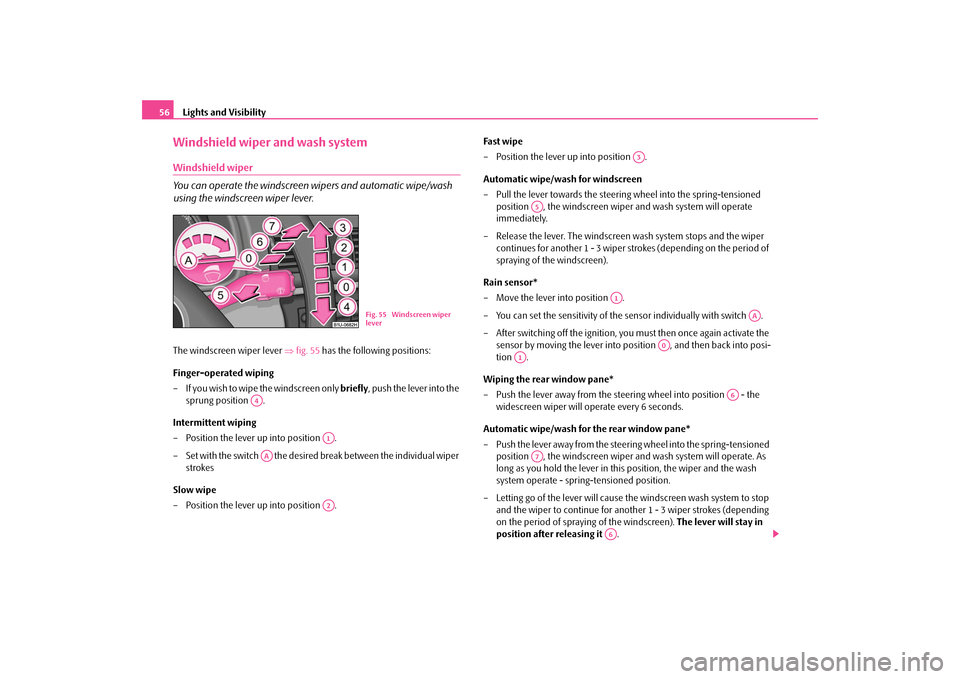
Lights and Visibility
56
Windshield wiper and wash systemWindshield wiper You can operate the windscreen wipers and automatic wipe/wash using the windscreen wiper lever.The windscreen wiper lever
β
fig. 55
has the following positions:
Finger-operated wiping β If you wish to wipe the windscreen only
briefly
, push the lever into the
sprung position .
Intermittent wiping β Position the lever up into position . β Set with the switch the desired break between the individual wiper
strokes
Slow wipe β Position the lever up into position .
Fast wipe β Position the lever up into position . Automatic wipe/wash for windscreen β Pull the lever towards the steering wheel into the spring-tensioned
position , the windscreen wiper and wash system will operate immediately.
β Release the lever. The windscreen wash system stops and the wiper
continues for another 1 - 3 wiper strokes (depending on the period of spraying of the windscreen).
Rain sensor* β Move the lever into position . β You can set the sensitivity of the
sensor individually with switch .
β After switching off the ignition, you must then once again activate the
sensor by moving the lever into po
sition , and then back into posi-
tion .
Wiping the rear window pane* β Push the lever away from the steering wheel into position - the
widescreen wiper will operate every 6 seconds.
Automatic wipe/wash for the rear window pane* β Push the lever away from the steering wheel into the spring-tensioned
position , the windscreen wiper and wash system will operate. As long as you hold the lever in this position, the wiper and the wash system operate - spring-tensioned position.
β Letting go of the lever will cause th
e windscreen wash system to stop
and the wiper to continue for anothe
r 1 - 3 wiper strokes (depending
on the period of spraying of the windscreen).
The lever will stay in
position after releasing it
.
Fig. 55 Windscreen wiper lever
A4
A1
AA
A2
A3
A5
A1
AA
A0
A1
A6
A7
A6
s2g8.b.book Page 56 Tuesday, April 7, 2009 8:53 AM
Page 58 of 224
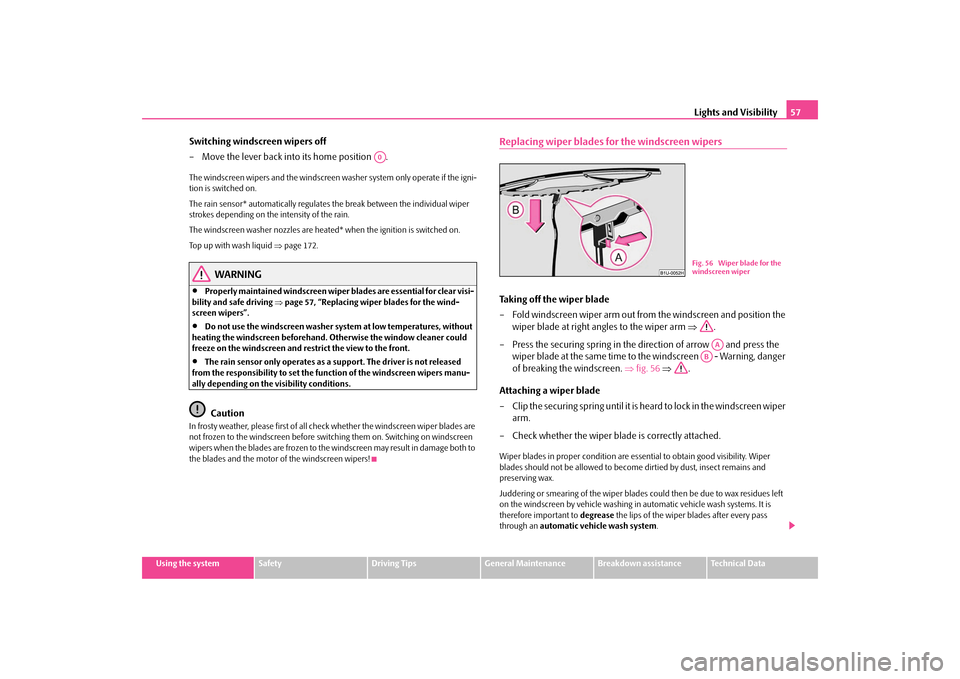
Lights and Visibility
57
Using the system
Safety
Driving Tips
General Maintenance
Breakdown assistance
Technical Data
Switching windscreen wipers off β Move the lever back into its home position .The windscreen wipers and the windscreen washer system only operate if the igni- tion is switched on. The rain sensor* automatically regulates
the break between the individual wiper
strokes depending on the intensity of the rain. The windscreen washer nozzles are heated* when the ignition is switched on.Top up with wash liquid
βpage 172.
WARNING
β’
Properly maintained windscreen wiper
blades are essential for clear visi-
bility and safe driving
βpage 57, βReplacing wiper blades for the wind-
screen wipersβ.β’
Do not use the windscreen washer sy
stem at low temperatures, without
heating the windscreen beforehand. Otherwise the window cleaner could freeze on the windscreen and re
strict the view to the front.
β’
The rain sensor only operates as a
support. The driver is not released
from the responsibility to set the function of the windscreen wipers manu- ally depending on the visibility conditions.
Caution
In frosty weather, please first of all check whether the windscreen wiper blades are not frozen to the windscreen before swit
ching them on. Switching on windscreen
wipers when the blades are frozen to the windscreen may result in damage both to the blades and the motor of the windscreen wipers!
Replacing wiper blades for the windscreen wipersTaking off the wiper blade β Fold windscreen wiper arm out from
the windscreen and position the
wiper blade at right angles to the wiper arm
β
.
β Press the securing spring in the direction of arrow and press the
wiper blade at the same time to th
e windscreen - Warning, danger
of breaking the windscreen.
β
fig. 56
β
.
Attaching a wiper blade β Clip the securing spring until it is
heard to lock in the windscreen wiper
arm.
β Check whether the wiper blade is correctly attached.Wiper blades in proper condition are esse
ntial to obtain good visibility. Wiper
blades should not be allowed to become
dirtied by dust, insect remains and
preserving wax. Juddering or smearing of the wiper blades
could then be due to wax residues left
on the windscreen by vehicle washing in
automatic vehicle wash systems. It is
therefore important to
degrease
the lips of the wiper blades after every pass
through an
automatic vehicle wash system
.
A0
Fig. 56 Wiper blade for the windscreen wiper
AA
AB
s2g8.b.book Page 57 Tuesday, April 7, 2009 8:53 AM
Page 59 of 224
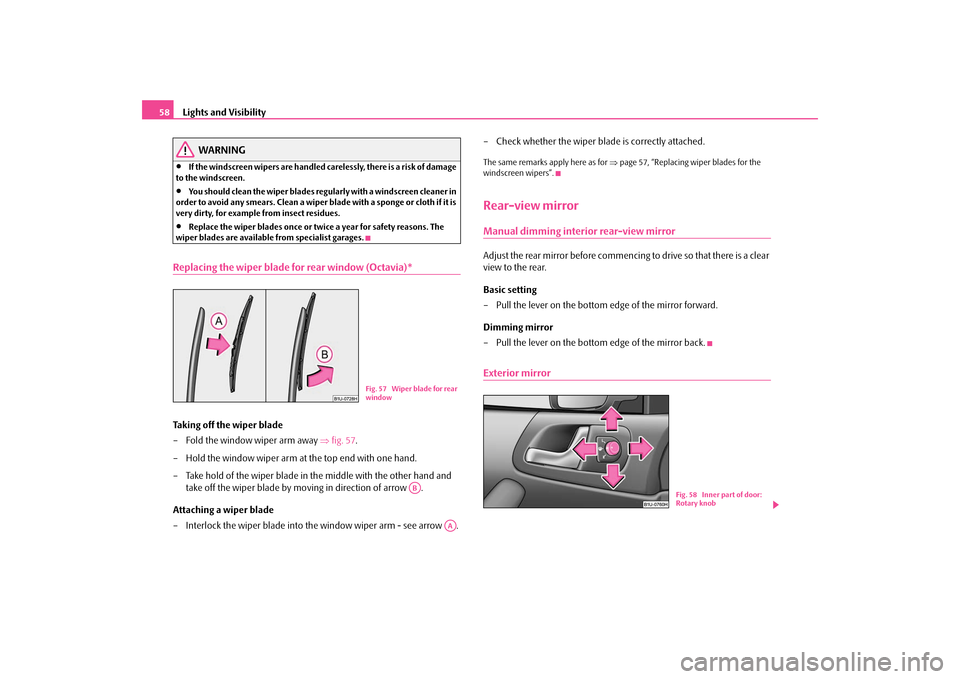
Lights and Visibility
58
WARNING
β’
If the windscreen wipers are handled carelessly, there is a risk of damage
to the windscreen.β’
You should clean the wiper blades regularly with a windscreen cleaner in
order to avoid any smears. Clean a wiper bl
ade with a sponge or cloth if it is
very dirty, for example
from insect residues.
β’
Replace the wiper blades once or twice a year for safety reasons. The
wiper blades are available from specialist garages.Replacing the wiper blade for rear window (Octavia)*Taking off the wiper blade β Fold the window wiper arm away
β
fig. 57
.
β Hold the window wiper arm at the top end with one hand.β Take hold of the wiper blade in the middle with the other hand and
take off the wiper blade by mo
ving in direction of arrow .
Attaching a wiper blade β Interlock the wiper blade into the window wiper arm - see arrow .
β Check whether the wiper blade is correctly attached.The same remarks apply here as for
βpage 57, βReplacing wi
per blades for the
windscreen wipersβ.Rear-view mirrorManual dimming interior rear-view mirrorAdjust the rear mirror before commencin
g to drive so that there is a clear
view to the rear. Basic setting β Pull the lever on the bottom edge of the mirror forward. Dimming mirror β Pull the lever on the bottom edge of the mirror back.Exterior mirror
Fig. 57 Wiper blade for rear window
AB
AA
Fig. 58 Inner part of door: Rotary knob
s2g8.b.book Page 58 Tuesday, April 7, 2009 8:53 AM
Page 60 of 224
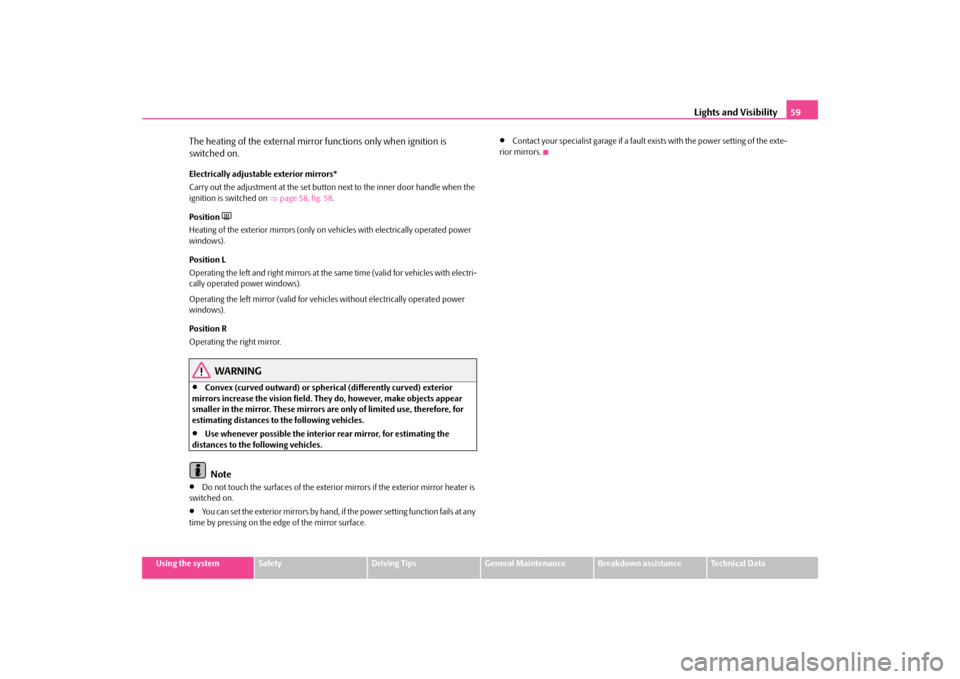
Lights and Visibility
59
Using the system
Safety
Driving Tips
General Maintenance
Breakdown assistance
Technical Data
The heating of the external mirror functions only when ignition is switched on.Electrically adjustable exterior mirrors* Carry out the adjustment at the set button
next to the inner door handle when the
ignition is switched on
βpage 58, fig. 58
.
Position
ο
Heating of the exterior mirrors (only on vehicles with electrically operated power windows). Position L Operating the left and right mirrors at the same time (valid for vehicles with electri- cally operated power windows). Operating the left mirror (valid for vehicles without electrically operated power windows). Position R Operating the right mirror.
WARNING
β’
Convex (curved outward) or spherical (differently curved) exterior
mirrors increase the vision field. They do, however, make objects appear smaller in the mirror. These mirrors are only of limited use, therefore, for estimating distances to the following vehicles.β’
Use whenever possible the interior rear mirror, for estimating the
distances to the following vehicles.
Note
β’
Do not touch the surfaces of the exterior mirrors if the exterior mirror heater is
switched on.β’
You can set the exterior mirrors by hand, if
the power setting function fails at any
time by pressing on the edge of the mirror surface.
β’
Contact your specialist garage if a fault exists with the power setting of the exte-
rior mirrors.
s2g8.b.book Page 59 Tuesday, April 7, 2009 8:53 AM
Page 62 of 224
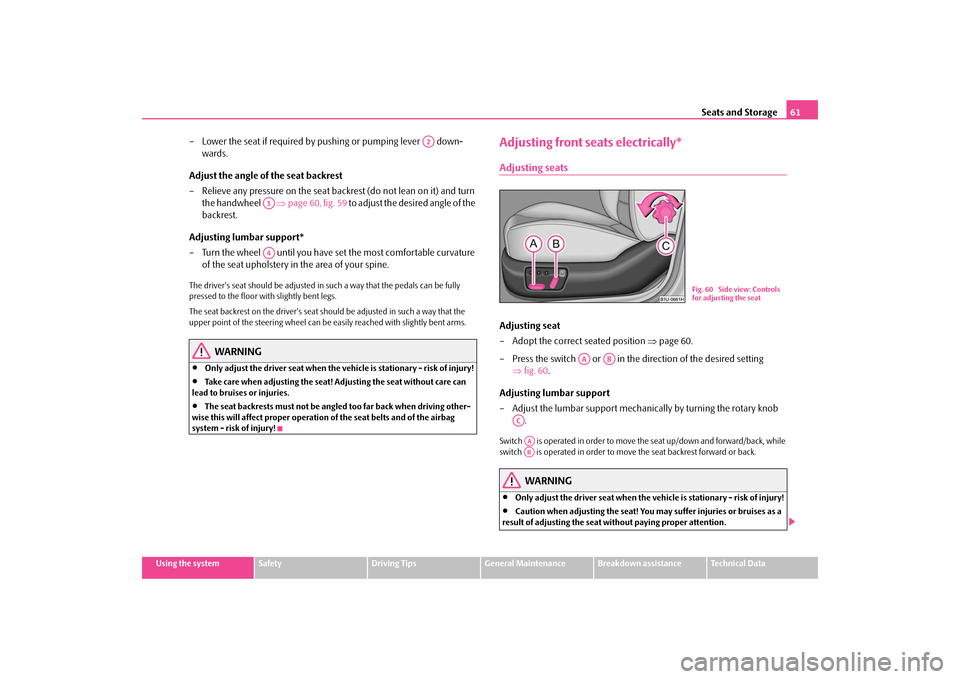
Seats and Storage
61
Using the system
Safety
Driving Tips
General Maintenance
Breakdown assistance
Technical Data
β Lower the seat if required by pushing or pumping lever down-
wards.
Adjust the angle of the seat backrest β Relieve any pressure on the seat backrest (do not lean on it) and turn
the handwheel
β
page 60, fig. 59
to adjust the desired angle of the
backrest.
Adjusting lumbar support* β Turn the wheel until you have set the most comfortable curvature
of the seat upholstery in the area of your spine.
The driver's seat should be adjusted in
such a way that the pedals can be fully
pressed to the floor with slightly bent legs. The seat backrest on the driver's seat sh
ould be adjusted in such a way that the
upper point of the steering wheel can be
easily reached with slightly bent arms.
WARNING
β’
Only adjust the driver seat when the ve
hicle is stationary - risk of injury!
β’
Take care when adjusting the seat! Adjusting the seat without care can
lead to bruises or injuries.β’
The seat backrests must not be angled too far back when driving other-
wise this will affect proper operation of the seat belts and of the airbag system - risk of injury!
Adjusting front seats electrically*Adjusting seatsAdjusting seat β Adopt the correct seated position
β
page 60.
β Press the switch or in the direction of the desired setting
β
fig. 60
.
Adjusting lumbar support β Adjust the lumbar support mechanically by turning the rotary knob
.
Switch is operated in order to move the seat up/down and forward/back, while switch is operated in order to move the seat backrest forward or back.
WARNING
β’
Only adjust the driver seat when the vehicle is stationary - risk of injury!
β’
Caution when adjusting the seat! You ma
y suffer injuries or bruises as a
result of adjusting the seat without paying proper attention.
A2
A3A4
Fig. 60 Side view: Controls for adjusting the seat
AA
AB
ACAAAB
s2g8.b.book Page 61 Tuesday, April 7, 2009 8:53 AM
Page 67 of 224
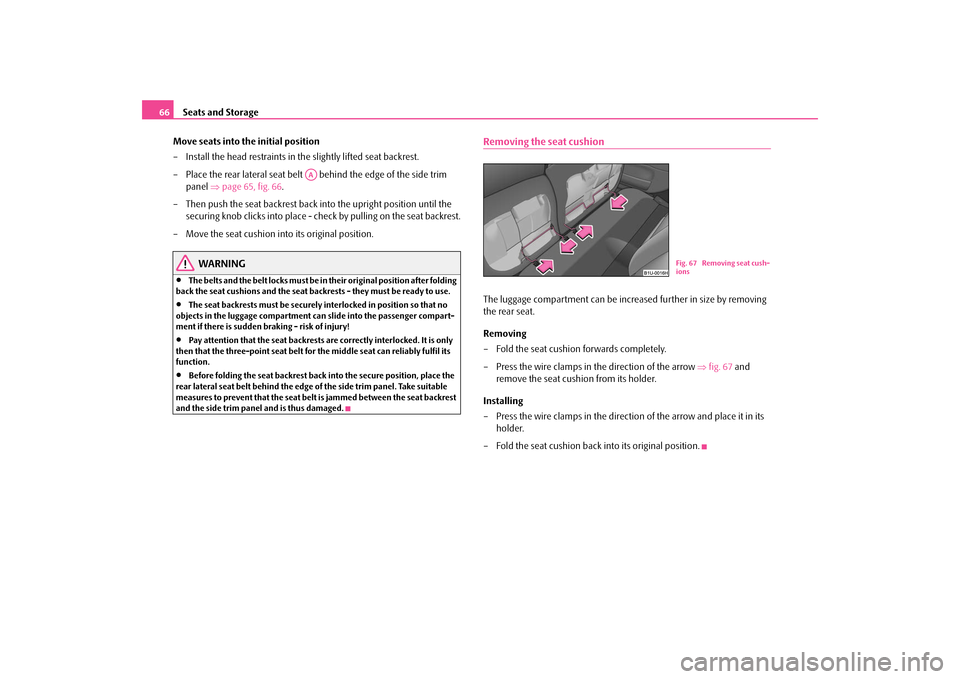
Seats and Storage
66
Move seats into the initial position β Install the head restraints in the slightly lifted seat backrest. β Place the rear lateral seat belt behind the edge of the side trim
panel
β
page 65, fig. 66
.
β Then push the seat backrest back
into the upright position until the
securing knob clicks into place - ch
eck by pulling on the seat backrest.
β Move the seat cushion into its original position.
WARNING
β’
The belts and the belt locks must be in
their original position after folding
back the seat cushions and the seat backrests - they must be ready to use.β’
The seat backrests must be securely interlocked in position so that no
objects in the luggage compartment ca
n slide into the passenger compart-
ment if there is sudden braking - risk of injury!β’
Pay attention that the seat backrests are correctly interlocked. It is only
then that the three-point seat belt for the middle seat can reliably fulfil its function.β’
Before folding the seat backrest back
into the secure position, place the
rear lateral seat belt behind the edge of the side trim panel. Take suitable measures to prevent that the seat belt
is jammed between the seat backrest
and the side trim panel and is thus damaged.
Removing the seat cushionThe luggage compartment can be increased further in size by removing the rear seat. Removing β Fold the seat cushion forwards completely. β Press the wire clamps in the direction of the arrow
β
fig. 67
and
remove the seat cushion from its holder.
Installing β Press the wire clamps in the direction of the arrow and place it in its
holder.
β Fold the seat cushion back into its original position.
AA
Fig. 67 Removing seat cush- ions
s2g8.b.book Page 66 Tuesday, April 7, 2009 8:53 AM
Page 69 of 224
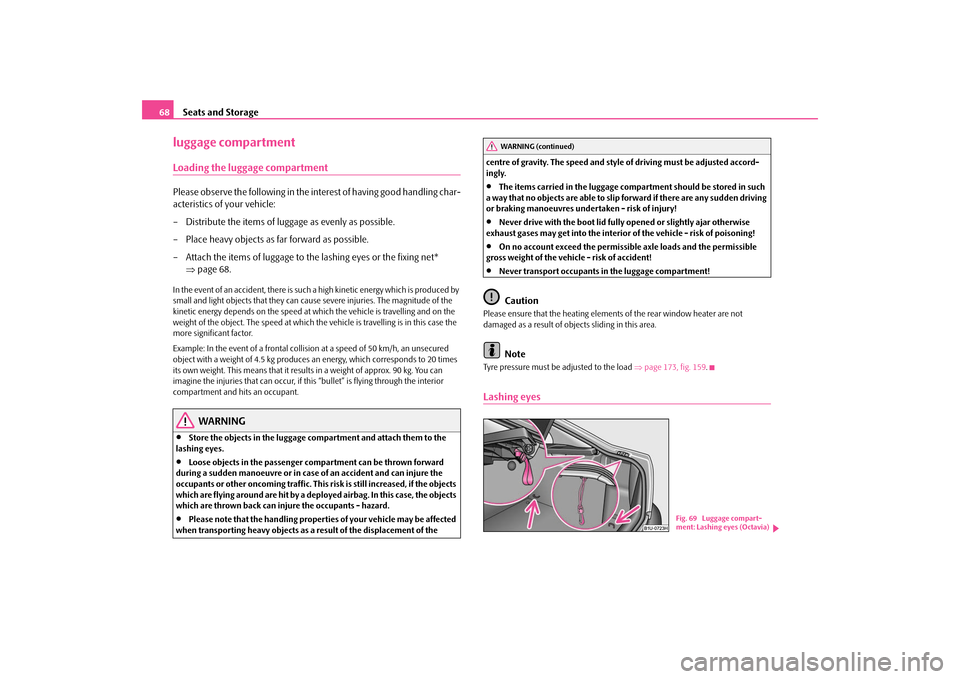
Seats and Storage
68
luggage compartmentLoading the luggage compartmentPlease observe the following in the inte
rest of having good handling char-
acteristics of your vehicle: β Distribute the items of luggage as evenly as possible.β Place heavy objects as far forward as possible. β Attach the items of luggage to the lashing eyes or the fixing net*
β
page 68.
In the event of an accident, there is such a
high kinetic energy wh
ich is produced by
small and light objects that they can caus
e severe injuries. The magnitude of the
kinetic energy depends on the speed at wh
ich the vehicle is travelling and on the
weight of the object. The speed at which the
vehicle is travelling is in this case the
more significant factor. Example: In the event of a frontal collision at a speed of 50 km/h, an unsecured object with a weight of 4.5 kg produces
an energy, which corresponds to 20 times
its own weight. This means that it results in a weight of approx. 90 kg. You can imagine the injuries that can occur, if th
is βbulletβ is flying
through the interior
compartment and hits an occupant.
WARNING
β’
Store the objects in the luggage comp
artment and attach them to the
lashing eyes.β’
Loose objects in the passenger compartment can be thrown forward
during a sudden manoeuvre or in case of an accident and can injure the occupants or other oncoming traffic. This risk is still increased, if the objects which are flying around are hit by a depl
oyed airbag. In this case, the objects
which are thrown back can injure the occupants - hazard.β’
Please note that the handling properti
es of your vehicle may be affected
when transporting heavy objects as a result of the displacement of the
centre of gravity. The speed and style
of driving must be adjusted accord-
ingly.β’
The items carried in the luggage compar
tment should be stored in such
a way that no objects are able to slip forward if there are any sudden driving or braking manoeuvres undertaken - risk of injury!β’
Never drive with the boot lid fully opened or slightly ajar otherwise
exhaust gases may get into the interior
of the vehicle - risk of poisoning!
β’
On no account exceed the permissi
ble axle loads and the permissible
gross weight of the vehicle - risk of accident!β’
Never transport occupants
in the luggage compartment!
Caution
Please ensure that the heating elements of the rear window heater are not damaged as a result of objects sliding in this area.
Note
Tyre pressure must be adjusted to the load
βpage 173, fig. 159
.
Lashing eyes
WARNING (continued)
Fig. 69 Luggage compart- ment: Lashing eyes (Octavia)
s2g8.b.book Page 68 Tuesday, April 7, 2009 8:53 AM
Page 72 of 224
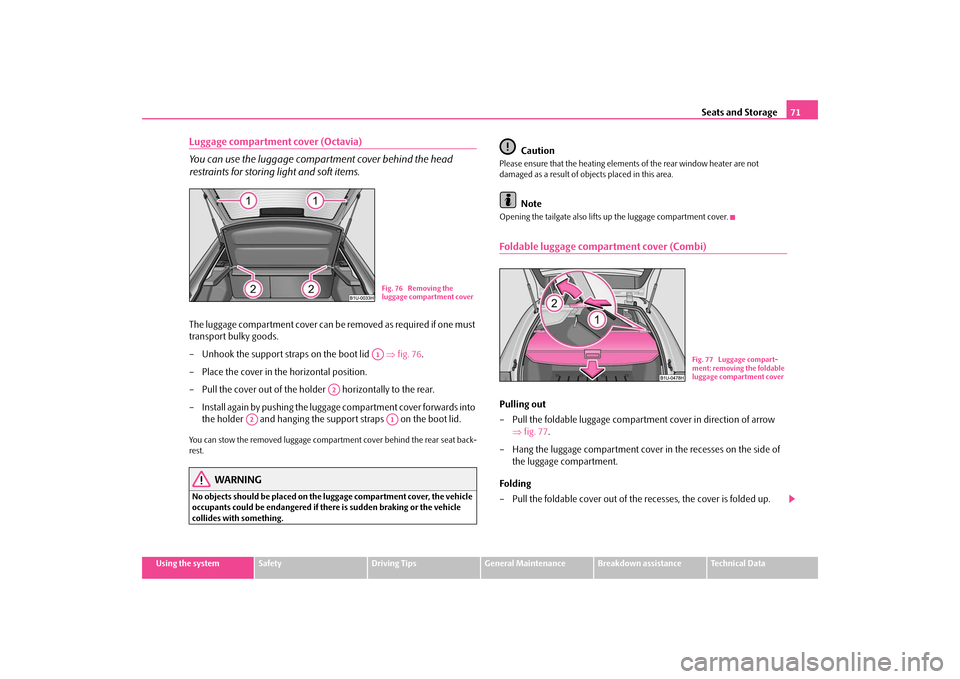
Seats and Storage
71
Using the system
Safety
Driving Tips
General Maintenance
Breakdown assistance
Technical Data
Luggage compartment cover (Octavia) You can use the luggage compartment cover behind the head restraints for storing
light and soft items.
The luggage compartment cover can be
removed as required if one must
transport bulky goods. β Unhook the support stra
ps on the boot lid
β
fig. 76
.
β Place the cover in the horizontal position. β Pull the cover out of the holder horizontally to the rear.β Install again by pushing the luggage
compartment cover forwards into
the holder and hanging the suppo
rt straps on the boot lid.
You can stow the removed luggage compartment cover behind the rear seat back- rest.
WARNING
No objects should be placed on the
luggage compartment cover, the vehicle
occupants could be endangered if th
ere is sudden braking or the vehicle
collides with something.
Caution
Please ensure that the heating elements of the rear window heater are not damaged as a result of obje
cts placed in this area.
Note
Opening the tailgate also lifts up the luggage compartment cover.Foldable luggage compartment cover (Combi)Pulling out β Pull the foldable luggage compartment cover in direction of arrow
β
fig. 77
.
β Hang the luggage compartment cover in the recesses on the side of
the luggage compartment.
Folding β Pull the foldable cover out of the recesses, the cover is folded up.
Fig. 76 Removing the luggage compartment coverA1
A2
A2
A1
Fig. 77 Luggage compart-ment: removing the foldable luggage compartment cover
s2g8.b.book Page 71 Tuesday, April 7, 2009 8:53 AM
Page 75 of 224
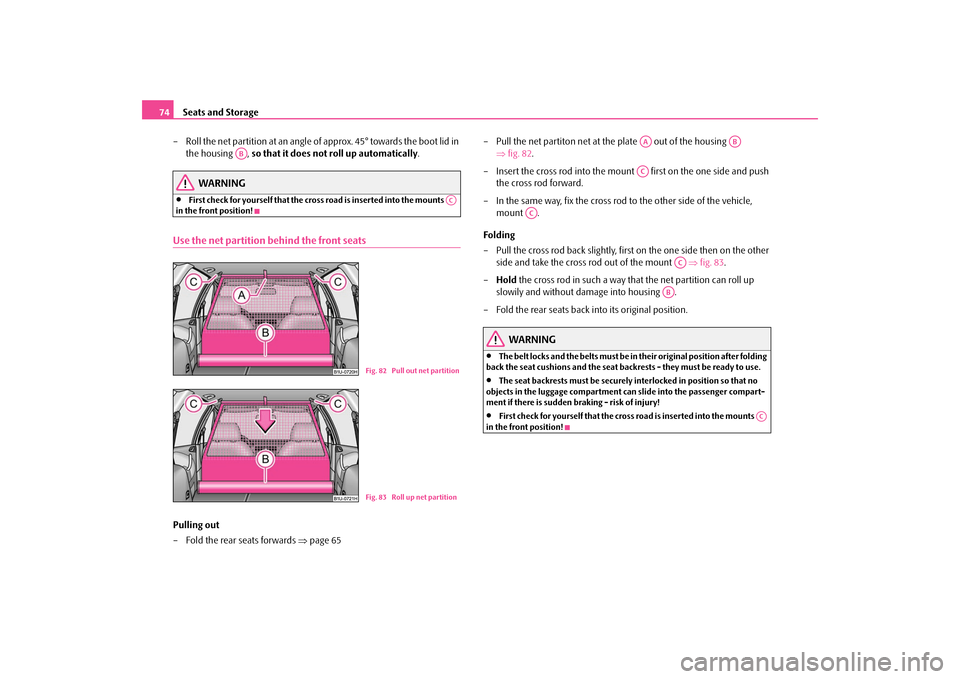
Seats and Storage
74
β Roll the net partition at an angle of
approx. 45Β° towards the boot lid in
the housing ,
so that it does not roll up automatically
.
WARNING
β’
First check for yourself that the cros
s road is inserted into the mounts
in the front position!Use the net partition behind the front seatsPulling out β Fold the rear seats forwards
β
page 65
β Pull the net partiton net at the plate out of the housing
β
fig. 82
.
β Insert the cross rod into the mount first on the one side and push
the cross rod forward.
β In the same way, fix the cross rod to the other side of the vehicle,
mount .
Folding β Pull the cross rod back slightly, first on the one side then on the other
side and take the cross rod out of the mount
β
fig. 83
.
β
Hold
the cross rod in such a way that the net partition can roll up
slowily and without damage into housing .
β Fold the rear seats back into its original position.
WARNING
β’
The belt locks and the belts must be in their original position after folding
back the seat cushions and the seat backrests - they must be ready to use.β’
The seat backrests must be securely interlocked in position so that no
objects in the luggage compartment ca
n slide into the passenger compart-
ment if there is sudden braking - risk of injury!β’
First check for yourself that the cross
road is inserted into the mounts
in the front position!
AB
AC
Fig. 82 Pull out net partitionFig. 83 Roll up net partition
AA
AB
AC
AC
AC
AB
AC
s2g8.b.book Page 74 Tuesday, April 7, 2009 8:53 AM
Page 79 of 224
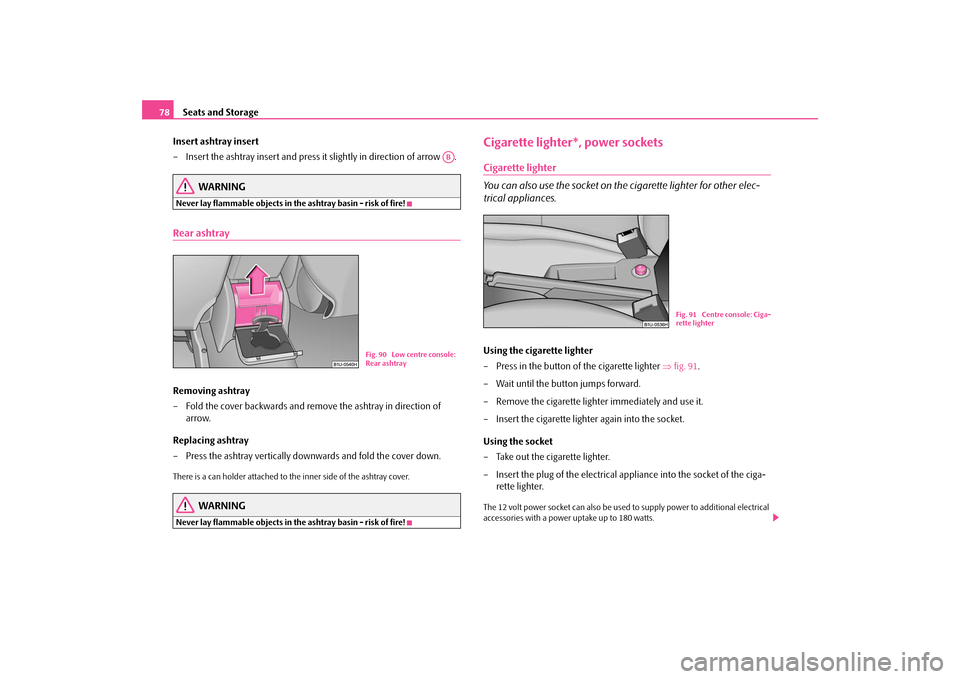
Seats and Storage
78
Insert ashtray insert β Insert the ashtray insert and press it slightly in direction of arrow .
WARNING
Never lay flammable objects in the ashtray basin - risk of fire!Rear ashtrayRemoving ashtrayβ Fold the cover backwards and remove the ashtray in direction of
arrow.
Replacing ashtray β Press the ashtray vertically downwards and fold the cover down.There is a can holder attached to
the inner side of
the ashtray cover.
WARNING
Never lay flammable objects in the ashtray basin - risk of fire!
Cigarette lighter*, power socketsCigarette lighter You can also use the socket on th
e cigarette lighter for other elec-
trical appliances.Using the cigarette lighter β Press in the button of the cigarette lighter
β
fig. 91
.
β Wait until the button jumps forward. β Remove the cigarette lighter immediately and use it.β Insert the cigarette lighter again into the socket. Using the socket β Take out the cigarette lighter. β Insert the plug of the electrical a
ppliance into the socket of the ciga-
rette lighter.
The 12 volt power socket can also be used
to supply power to a
dditional electrical
accessories with a power uptake up to 180 watts.
AB
Fig. 90 Low centre console: Rear ashtray
Fig. 91 Centre console: Ciga-rette lighter
s2g8.b.book Page 78 Tuesday, April 7, 2009 8:53 AM